Soviet strategic planning on the eve of World War II. Part of 1. Counterattack and preemptive strike
- There is still no confirmation of this. But no one knows what Stalin really wanted.
The sleep of reason gives birth to monsters. In fact, having failed to respond in time to the challenge of time, the Soviet researchers of the Second World War and the Great Patriotic War “overslept” the revival of the old monstrous Nazi myth of the Red Army’s readiness in the summer of 1941 to deliver a preventive strike on Germany. Moreover, the almost complete absence of serious studies of Soviet prewar planning and the reasons for the defeat of the Red Army in the summer of 1941, together with their closeness, allowed the old myth to gain wide popularity in a short time.
An attempt to combat it by refuting its individual elements, since "a fundamentally correct idea is sometimes supported by not very reliable, and sometimes simply erroneous considerations," did not bring success. Indeed, “it is not enough to criticize the arguments of the opponent in the dispute. This will show only that his position is poorly founded and shaky. To reveal its fallacy, it is necessary to convincingly substantiate the opposite position. ”
The poor knowledge of the events of the summer of 1941 provoked a heated discussion about the plans of the Soviet military and political leadership on the eve of World War II and their role in the catastrophic defeat of the Red Army in the summer of 1941. Three scenarios were proposed: the Red Army was preparing for defense, a preemptive attack on Germany, or the defeat of the Wehrmacht on the territory of the USSR. Currently, the discussion is at an impasse. The materials available to the researchers did not give an unambiguous answer, moreover, all three parties confirm the truth of their version of Soviet planning with the same documents.
In this paper, an attempt will be made to get out of the current stalemate through detailed study and rethinking of the documents of Soviet prewar planning introduced into the scientific circulation. The novelty of the work lies in the close examination of Soviet prewar planning, showing the development, opening its mechanism. Particular attention is paid to explaining the reasons for the military failures of the Red Army in the border battle of the summer of 1941. For the first time in detail and convincingly, with reference to specific documents, a plan for the defeat of Wehrmacht troops in the territory of the Soviet Union is shown.
The last plan for the strategic deployment of the Red Army in the event of war was developed before the outbreak of World War II during the Czechoslovak crisis on March 24, 1938 after a statement by the USSR government about the readiness of the Soviet Union to help Czechoslovakia in the event of German aggression. The plan provided for the confrontation of two military blocs: on the one hand France, Czechoslovakia and the USSR, on the other - Germany, Italy, Japan, Poland, Finland, Estonia and Latvia. It was assumed that Italy would take part in hostilities solely by its naval fleet, Lithuania will be occupied by Germany and Poland in the early days of the war, and Romania and Turkey, under certain circumstances, may oppose the USSR.
It was assumed that Germany would deploy 14 divisions against France, Germany and Poland would deploy 33 divisions against Czechoslovakia, and against the USSR Germany, Poland, Latvia, Estonia and Finland would concentrate 144 divisions and 16 cavalry brigades, to which the USSR would oppose 139 divisions and 26 tank brigades. According to the plan of the command of the Red Army, the smaller number of Soviet troops was to be compensated for by their better mechanization.
In total, two options were developed for the Red Army in case of war. The first involved the deployment of the main forces of Germany, Latvia and Poland north of the Pripyat marshes, the second - the deployment of the main forces of Germany and Poland south of the Pripyat marshes. In both cases, it was envisaged that the enemy would be defeated with a frontal strike by the Soviet troops on the largest enemy grouping. In the first version, from 70 to 82, the Soviet divisions and 11 tank brigades (12 divisions of the RGK were supposed to defeat Estonian and Latvian troops north of the Pripyat swamps, had to break up German-Polish-Latvian forces to the north of the Pripyat swamps if they entered the war of Estonia and Latvia) divisions and 88 cavalry brigades on a wide front from Sventsyan to Baranavichy, ensuring the main strike on both banks of the Neman with strikes from Polotsk and Slutsk. The 3 Soviet divisions and the 38 tank brigades were to break up the 9 Polish divisions and the 40 cavalry brigades south of the Pripyat Marshes on a narrow front from Rovno to Brod (13 scheme).
In the second version, from 80 to 86 divisions and from 13 to 15, the tank brigades of the Soviet group (6 divisions and 3 tank brigades of the northern Soviet group should strengthen the Soviet grouping south of the Pripyat marshes) in case of neutrality of Finland, Estonia and Latvia the grouping of 86 divisions and 13 cavalry brigades on a broad front from Rivne to Ternopil, ensuring the main attack on Lublin with strikes on Kovel and Lviv, and the 37 of the Soviet divisions and 7 tank brigades were to oppose in Germany and Poland 62 divisions and 3 cavalry brigades on the narrow front from Oshmyan to Navagrudak (Scheme 2). The influence of the change in the number of groups on the tasks assigned to it: the increase in group increases and the decrease reduces the width of the front and the depth of impact.
The Munich agreement of England and France with Germany and Italy made it impossible to render military assistance to the USSR to Czechoslovakia. After the Munich guarantees of the new borders of Czechoslovakia, the military assistance of the Soviet Union of Czechoslovakia led to war with at least Britain, France, Germany and Italy, and at most with all of Europe. At the same time, the subsequent cooling of Germany’s relations with Britain and France predetermined its rapprochement with the Soviet Union. By concluding a non-aggression pact in 1939 and secretly dividing a part of Europe into spheres of influence, Germany and the USSR proceeded to redistribute borders in Europe in accordance with their agreements: Germany attacked Poland, occupied Norway, Denmark, the Netherlands, Belgium and part of France, While the Soviet Union regained Bessarabia, Western Belorussia and Ukraine, it annexed Northern Bukovina and pushed its border away from Leningrad. In the Far East, the Soviet Union, having defeated the Japanese provocateurs on the Khalkhin Gol River, for a long time repulsed Tokyo’s desire to wage a large-scale war with the USSR.
In the course of military operations in Poland, Finland, Romania and Mongolia, the Soviet Union gained invaluable combat experience: on the Khalkhin-Gol river — on encircling and defeating the enemy, on the Karelian Isthmus — on breaking through heavily fortified areas, in Western Belarus and Ukraine, and Bessarabia - maneuvering operations and the use of mechanized corps, and in Bessarabia - the use of airborne troops. The knowledge tested and tested during real military operations was used in August 1940 to develop a new strategic deployment plan, taking into account the increasing numbers of the Red Army and the new borders of the USSR.
As in the previous plan, Germany remained as the main enemy. There is nothing surprising or reprehensible in the development of a plan for waging war with friendly Germany for the 1940 year of the USSR. The USSR, as indeed any other country, did not have permanent friends, but there was a constant need to ensure the security of its borders, especially with such a non-permanent "friend" as Hitler's Germany. That is why, in the summer of 1940, I. Stalin decided to deepen the friendship of the USSR with Germany for the sake of dividing the Balkans into spheres of influence and putting the Black Sea straits at the disposal of the USSR so as not to repeat the unenviable fate of England and France, for whom friendship with Germany turned into open hostility, and giving Soviet diplomats freedom of action against Germany, at the same time demanded that their military provide security guarantees to the USSR against any surprises from Germany.
It was assumed that Germany, Finland, Hungary and Romania would deploy 179 divisions against the Soviet 14 divisions and 233 tank brigades on the border with the USSR. The concentration of the main grouping of Germany in the east was expected north of the Pripyatsky marshes for drawing from East Prussia either a strike on Riga and Polotsk, or a concentric strike from Suvalki and Brest on Minsk. In the area of Liepāja and Tallinn, amphibious assault forces were expected: one for attacking the flank to the Soviet troops in the Baltic, the other for a concentric strike against Leningrad with the Finnish troops. South of the Pripyat swamps, 50 German divisions were expected to bypass the rear of the Lvov group of Soviet troops, and from the Botosani area - a strike of the Romanian troops on Zhmerinka.
To counteract the main group of the German Red Army in the west in the 107 7 divisions and armored brigades were concentrated north of the Pripet Marshes, 62 4 division and armored brigade - to the south of the Pripet Marshes and the 11 3 divisions and armored brigades - on the border with Finland. It was supposed to deliver a frontal strike on the fortifications of East Prussia by the forces of the troops of the North-Western Front and the strike of part of the forces of the Western Front, bypassing these fortifications. For the defeat of the Lublin group of German troops provided for a concentric strike troops of the Western and South-Western fronts. It was planned to firmly cover the USSR border with Hungary and Romania. The reserve of the High Command was supposed to be placed behind the possible strikes of the German army for the sake of drawing an effective counterstrike on the German troops breaking through into the USSR (3 scheme).
However, since I. Stalin expected the leading powers to struggle for influence in the Balkans, he was not satisfied with the proposed plan, and the leadership of the Red Army was instructed to develop a plan with the concentration of the main forces of the Red Army south of the Pripyat marshes. Already 18 September 1940 was presented for approval a new strategic deployment plan, in which the option of deploying the main forces of the Red Army north of the Pripyat marshes was supplemented with the option of deploying the main forces of the Red Army south of the Pripyat marshes.
The South-Western Front was planned by forces of 6 armies and 94 armored brigades brought together in 7 together with a part of the forces of the Western Front to break the enemy’s Lublin and Lviv projections into Kielce and Krakow. The North-West and part of the forces of the Western Front were tasked with delivering an auxiliary strike in the general direction of Allenstein. The plan proposed to deepen the blow of the southern grouping of Soviet troops to Breslau, but the number of the Red Army grouping on the border with Germany in the 162 division and 13 tank brigades was not designed for this (4 scheme).
Together with the strategic deployment plan of 18 September 1940, the Soviet political leadership was offered to consider a plan for the defeat of the Finnish armed forces by the Red Army. Since the military action was planned to be carried out at a friendly position of Germany proposed concentration against 18 Finnish divisions 63 Soviet divisions and 3 armored brigades: 11 infantry divisions LenVO, 2 - PribOVO, 5 - OTDR, 8 - CVM, 7 - HVO, 4 - UrVO, 2 - SKVO, 6 - PrivO, 1 - ArchVO, 2 tank and 1 motorized divisions, 3 tank brigades, as well as 14 rifle divisions RGK from POVO and KOVO. It was planned to create two fronts - the North and North-West. The Northern Front 15 divisions, coming out in the Petsamo-Naoussi and Kemi areas to the Norwegian and Swedish frontiers, were supposed to stop the international assistance of Finland, while the 32 divisions and the 3 tank brigades of the North-Western Front, as well as the 2 divisions of the WGW, with two concentric strikes and the landing forces were to smash the main forces of the Finnish army and go to Tampere and Helsinki, as well as occupy the Aland Islands (5 scheme).
In a speech on October 1 radio, Winston Churchill stated: “Given security considerations, Russia cannot be interested in Germany settling on the shores of the Black Sea or occupying the Balkan countries and conquering the Slavic peoples of Southeast Europe. This would contradict Russia's historically established vital interests. ” Already 5 October 1940 was proposed for consideration, and 14 October approved the final strategic plan of the Red Army in the West with the main forces of the Red Army south of the Pripyat marshes as the main option. The composition of the South-Western Front, in order to ensure a guaranteed strike on Breslau, was increased to 126 divisions (including the 23 divisions of the WGCs) and 20 tank brigades, which had to be planned to increase the Red Army from the 226 divisions and 25 tank brigades to 268 divisions and 43 tanks (6 schema). Two circumstances draw attention to themselves. First, since the increase was planned to take place after the outbreak of hostilities for a whole year, it is not possible to talk about planning a preventive strike by the Red Army on Germany at this stage. We can talk exclusively about the application of a counterblow to the aggressor who invaded the territory of the USSR.
Secondly, since the plan envisaged the development of additional plans for conducting military operations with Finland, Romania and Turkey, he was preparing, no doubt, in the hope of deepening relations with Germany, jointly with her dividing the Balkans into spheres of influence, joining Finland, Southern Bukovina to the USSR and the Black Sea Straits. On the basis of this plan, in October 1940, a new plan for the mobilization deployment of the Red Army was adopted, proposing an increase in its membership to the 292 divisions and 43 brigades.
The increased number of the Red Army allowed the 134 divisions and 20 tank brigades to be concentrated within the South-Western Front and bring the Soviet units from the Lvov salient to the Baltic Sea coast in order to encircle and then destroy almost the entire Wehrmacht group in the East. After adopting the plan for concentrating the Red Army and the mobplan, the KOVO headquarters was instructed to develop a plan of action for the district troops in accordance with the October plan for concentrating the Red Army, and for the headquarters of the Leningrad Military District to develop a plan for Operation “With. 20 ”(“ revenge in the North-West ”), which was based on a plan from 18 of September 1940, taking into account the planned increase in the composition of the Red Army.
However, all these truly ambitious plans did not come true. In the Leningrad Military District the instruction of the Red Army Command to develop a plan for the final defeat of Finland “N-З. 20 "development has not received. In contrast to the Leningrad Military District, at KOVO, an action plan for the troops of the South-Western Front, according to the deployment plan for 1940, was already developed in December of 1940. The plan provided for the concentration of already 7 armies, 99 divisions and 19 tank brigades in the South-Western Front. The enemy was supposed to be defeated in three stages - mobilization, the destruction of the main enemy forces and his pursuit in the direction of Breslau to the Opeln-Kreisburg-Petrkov area by 5, 19, 6, 26 and 12 armies of the Southeast forces -West and part of the forces of the Western Fronts, as well as the defeat of the Romanian army by the concentric attack of the 18 and 9 armies on Iasi and the output of the 9 army units on the Bulgarian border (7 scheme). In full accordance with the October strategic deployment plan and the KOVO plan in January 1941, in connection with the appointment to the North Caucasus and the subsequent planned transfer to the western border, Tymoshenko told I. Konev: “We are counting on you. You will be a strike force if you need to strike. "
After a meeting of the top commanders of the Red Army in December 1940 of the year, two military-strategic games on the cards in January 1941, and the approval of KOVO commander G. Zhukov in February 1941, M. Kirponos was appointed head of the General Staff of the Red Army. Upon his arrival at KOVO, the developed cover plan was submitted to the new district commander, who at the beginning of February 1941 ordered the KOVO commanders to order 15 in March 1941 to develop army plans to cover the border. In mid-March, 1941, these plans were ready, and, according to the testimony of the head of the operational department of the KOVO headquarters, I. Baghramian, while "no major alterations were needed."
The General Staff of the Red Army monitored the development of the plan by the headquarters of the KOVO and “shortly after the Nazi occupation of Yugoslavia began ... gave instructions to introduce a number of significant amendments to the plan for covering the state border. The district command was ordered to significantly strengthen the troops advanced to the border. Four mechanized corps, four rifle divisions and a number of formations and units of special forces were additionally pulled here. ... The military council of the district, after carefully studying the new cover plan, approved it without delay. ” However, in early May 1941, the plan was rejected, and the KOVO command was ordered to develop a new plan for covering the border. To understand the reason for the refusal of the Red Army leadership from the KOVO plan, which became the pinnacle of the development of the strategic plans for the Red Army from August 19, September 18 and October 14 to October 1940, it is necessary to return to November 1940.
With the failure in November 1940 of the negotiations of V. Molotov with I. von Ribbentrop and A. Hitler, as well as the beginning of the diplomatic war between Germany and the USSR over Bulgaria, the issue of defeating Germany went from a theoretical plane to a practical one. Obviously, in this situation, the political and military leadership of the USSR decided, without giving up the initiative to the enemy, to defeat his armed forces, anticipating their mobilization and inflicting a preventive strike on Germany. In this situation, the agenda raised the question of increasing the composition of the Red Army to deliver a guaranteed and all-destructive preemptive strike by the KOVO grouping from the border of southern Poland to the Baltic coast, and a preventive strike demanded an increase in the composition of the Red Army in the pre-war period. Thus, the October strategic plan for the 1940 strategic deployment of the year, followed by the mobplan, the KOVO plan and the plans to defeat Finland, Romania and Turkey were canceled overnight and forgotten.
In December 1940, a meeting of the top commanders of the Red Army was held, at which new forms and methods of combat use of troops were considered taking into account the combat use of the armed forces of Germany, England and France in 1939-40. In early January, 1941 held two military-strategic games on the maps to determine the most effective preventive option of the Red Army in Germany - north or south of the Pripyat marshes to the Baltic Sea, bypassing the fortifications of East Prussia from Belostok and Lviv ledges, respectively. The development of a preemptive strike is indicated by the fact that both games began with offensive actions of the “Eastern” (USSR), while their actions to refine the reflection of the “Western” aggression were limited to a short and extremely vague preamble. In the first game, the “Eastern”, led by Pavlov, was struck around the fortifications of East Prussia, but the “Western”, inflicting a short counterstrike at the base of the “Eastern” offensive, questioned its effectiveness (8 scheme). At the game's analysis, the decision of D. Pavlov, who played for the “Eastern”, was recognized as correct, but with the proviso that for the success of such a deep strike, it is necessary to attract more forces and means.
In the second game, the "eastern" (USSR), striking south of the Pripyat marshes, quickly defeated the "southern" (Romania), "South-Western" (Hungary) and began a rapid advance into the territory of the "western" (Germany). That's it, this deployment option was approved as the main one (9 schema). Thus, for the second time, the southern version of the concentration of the Red Army in the West triumphed over the northern option. According to the results of the games, he led the "eastern" troops G. Zhukov in the second operational game on the maps by being appointed new chief of the General Staff of the Red Army to design and deliver a preemptive strike by the Red Army on Germany.
The fact that the strike was supposed to be exactly preventive, clearly indicates the appointment of J. Stalin to the start date of the March plan of G. Zhukov on 12 June 1941, as M. Meltyukhov and I. Stalin quite rightly noted, the date of the USSR attack on Germany could be appointed, and the date of the German attack on the USSR is not. In February, the 1941 of the year adopted a new mobilization plan providing for the transfer of the Red Army to the 314 divisions staff before the war (the 292 divisions deployed from the 22 tank brigades were added to the previous 43 divisions). In addition, apparently, everything was ready for the formation of a few dozen more divisions with the start of military operations.
11 March 1941, after the introduction of German troops in Bulgaria, and the British in Greece, the Soviet Union adopted a new strategic plan for the deployment of the Red Army, providing for the concentration of 144 divisions in the South-Western Front and in the North-Western and Western Fronts 82 division. This plan envisaged Germany striking the Baltic states on Riga and Daugavpils, Belarus on Volkovysk and Baranovichi with concentric strikes from Suvalki and Brest, and Ukraine on Kiev and Zhmerinka, with the aim of encircling and defeating the Lvov group of Soviet troops (10 scheme).
Fully March 1941 plan of the year has not been published anywhere else, however, it probably assumed a preemptive strike by the troops of the South-Western Front across Germany to the Baltic coast, with the aim of encircling and defeating the entire group of German forces in the East at once. The main difference of the March 1941 plan from the September and October 1940 plans is an increase in the grouping of the South-Western Front and the depth of the strike on Germany up to the Baltic coast, its mobilization and concentration in the pre-war period, the assumption is a decrease in the depth of Germany’s strike on the USSR in Belarus - not to Minsk, but to Baranavichy, and also, apparently, a strong link to the actions of the Anglo-Greek-Yugoslav-Turkish troops in the Balkan allies of Germany - Bulgaria, Italian Albania, Romania and Hungary.
The beginning of the development of plans for the introduction of troops into Iran by the USSR and England in March 1941 suggests the existence of some kind of agreement or agreement between them - England refuses the complete defeat of the Italians in North Africa and sends its troops to Greece from there to attack the Balkan allies of Germany and thus ensuring the unhindered defeat by the Red Army of the German grouping in the East, in exchange for protecting India from the attack of the troops of the German African Corps, Italy and France from North Africa and the Middle East East through Egypt, Palestine, Jordan, Iraq, Iran and further on to India (11 scheme). One thing is undoubtedly - in creating the Balkan front, Winston Churchill really sought to "cause a serious and favorable reaction in Soviet Russia."
Germany’s rapid defeat of Yugoslavia and Greece cooled I. Stalin’s determination to attack Germany. The March 1941 plan of the year was canceled. Evidently, Stalin denied friendship with W. Churchill and began to restore his relations with A. Hitler. Indicative in this regard is Stalin's categorical refusal of G. Zhukov’s proposal to be the first to attack Germany in accordance with plans of May 15 and June 13 of 1941.
The plan proposed by I. Stalin G. Zhukov on 15 of May 1941 of the year provided for a preemptive strike on Germany and Romania by the forces of 8 armies and 146 divisions of the South-Western Front and part of the forces of the Western Front with access to the Ostroleka-Olomouc line at the first stage, at the second - to the coast of the Baltic Sea in order to surround the East Prussian Wehrmacht group in the East. The reserve of the High Command of the Red Army behind the Western and Southwestern Fronts was to strike a counterattack on enemy units breaking through to Vilnius and Minsk, as well as to Kiev and Zhmerynka. The two armies of the RGK, stationed in the area of Sychevka, Vyazma, Yelny and Bryansk at the junction railway stations, were to strengthen the troops of either the Western or South-Western fronts if necessary.
The German offensive was planned to be parried by letting the German assault groups out to Minsk and Kiev: they divided the Pripyat swamps and presented absolutely no threat to the Red Army, while at the same time guaranteeing the safety of the offensive of the Southwestern Front from the counterattack of the German troops. At the same time, a reliable cover of the USSR border with Germany in the region of East Prussia prevented the Germans from breaking into the Baltic and surrounding the troops of the Western Front in the Baranavichy region (12 scheme). The plan from 13 June 1941 of the year, slightly different from the May plan in individual details, exactly repeated this scheme (13 scheme).
13 June 1941 of the year to the German government through diplomatic channels was transmitted published in the Soviet press 14 June 1941 of the TASS message about the absence of tension between Germany and the Soviet Union. To understand the motivation of I. Stalin, who finally and irrevocably refused to deliver a preemptive strike on Germany, let us return to December 1940 of the year to a meeting of the top commanders of the Red Army.
Thus, we found out that after the establishment of a new state border, the General Staff of the Red Army developed a new plan for the deployment of the armed forces of the Red Army. The initial strike of the 94 divisions and the 7 tank brigades from the Lvov ledge to Krakow (40% of the 226 KA divisions) was deepened by the 126 divisions and 20 tank brigades first to Breslau (47% of 268 divisions) and then 134 divisions, and by the 20, I’m set out one another, I’m going to be a bit more comfortable with Breslau (BNLX) 46 divisions and 292 tank brigades first to Breslau (XNUMX% from XNUMX divisions) and then XNUMX tank divisions from XNUMX KA divisions from XNUMX KA divisions from XNUMX KA divisions from XNUMX KA divisions from XNUMX KA divisions from XNUMX KA divisions. coast (XNUMX% of XNUMX divisions). Since the expansion of cooperation with Germany was envisaged, the planning was “just in case”. The priority was the question of the division of spheres of influence in the Balkans and the liberation of Finland, the remainder of Bukovina and the Straits.
The situation changed dramatically after the collapse of the negotiations of V. Molotov with the German political leadership in November 1940. The liberation campaign was canceled. On the agenda was the question of a preemptive strike on Germany. The size of the Red Army was promptly increased to the required state by the summer of 1941, planning was worked out, but the plan for a preventive attack on Germany was not accepted for implementation.
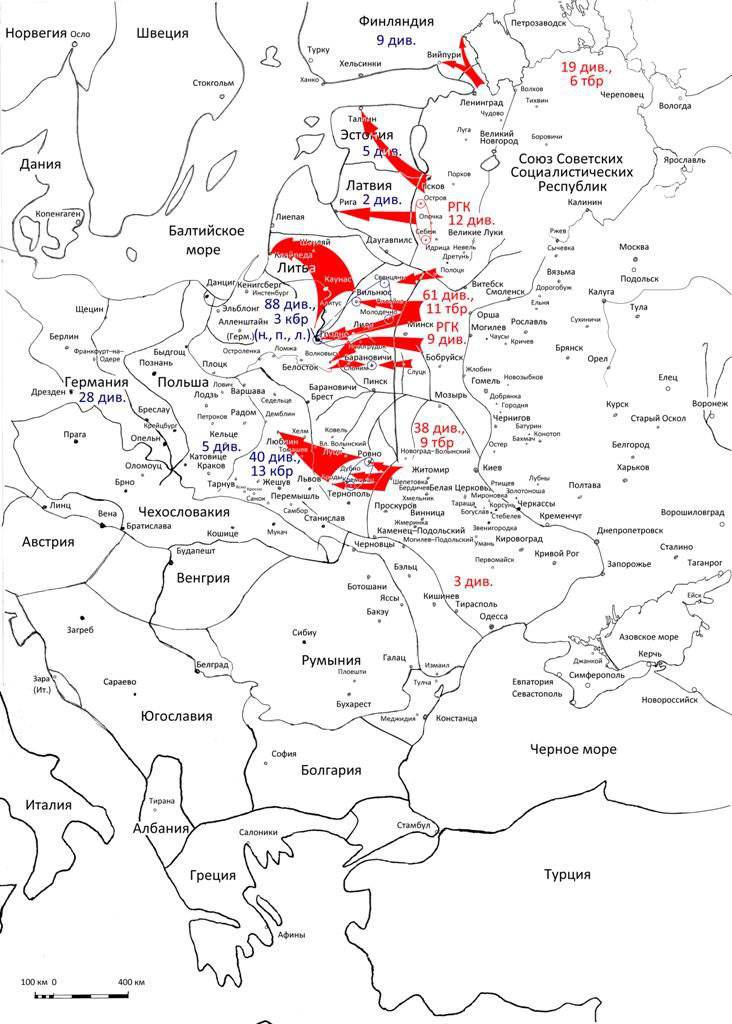
1 schema. Actions of the Armed Forces of the Red Army in the European theater of operations according to the deployment plan of March 24 from 1938 (Northern variant). Compiled by the note of the NGS KA BUT the USSR K.E. Voroshilov on the most likely opponents of the USSR // 1941. Collection of documents. In 2 pr. Prince 2 / Appendix № 11 // www.militera.lib.ru
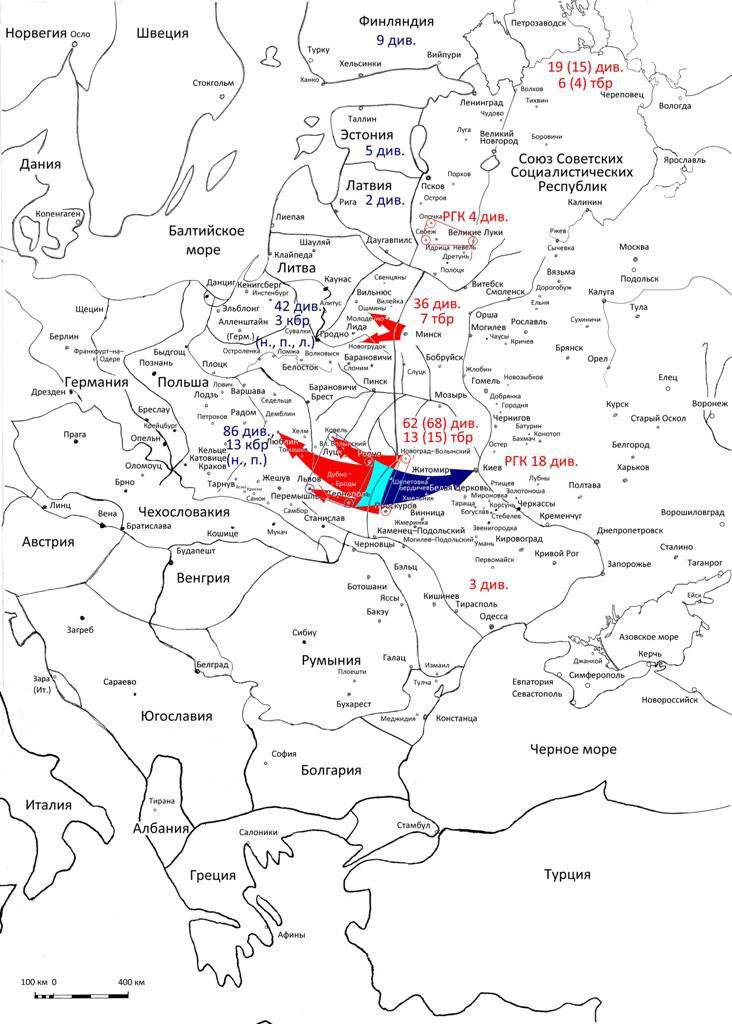
2 schema. Actions of the Armed Forces of the Red Army in the European theater of operations according to the deployment plan dated March 24 from 1938 (Southern variant). Compiled by the note of the NGS KA BUT the USSR K.E. Voroshilov on the most likely opponents of the USSR // 1941. Collection of documents. In 2 pr. Prince 2 / Appendix № 11 // www.militera.lib.ru
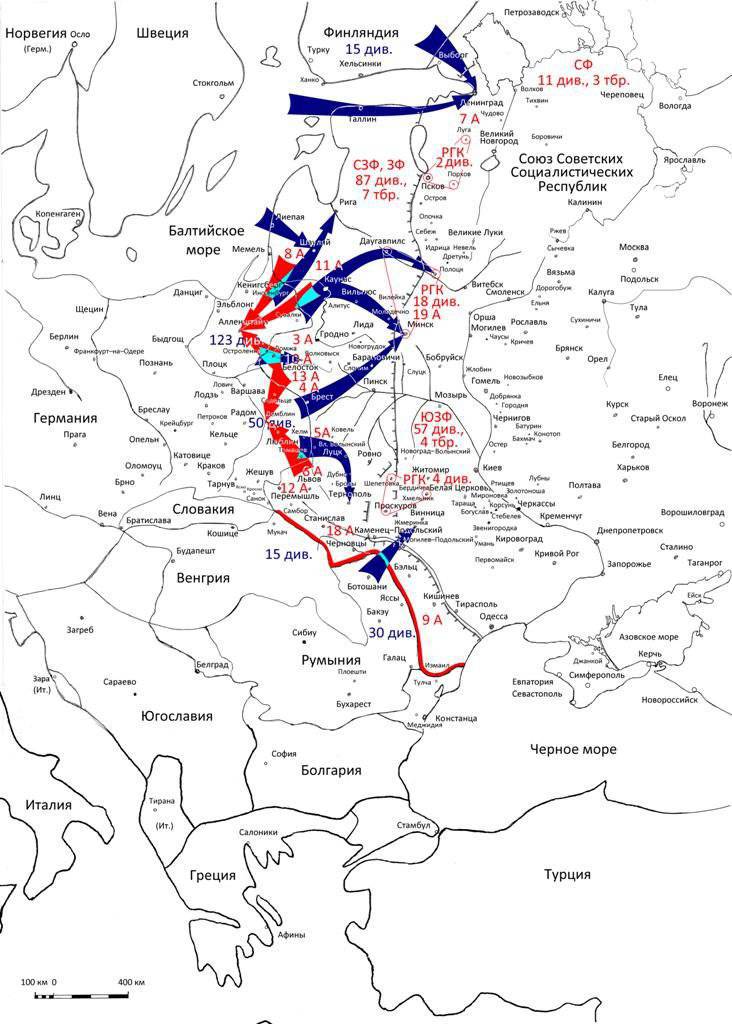
3 schema. Actions of the Armed Forces of the Red Army in the European theater of operations in accordance with the deployment plan of 19 in August of 1940. Compiled according to a note by the NO of the USSR and NGS KA in the Central Committee of the CPSU (b) I.V. Stalin and V.M. Molotov on the basics of the strategic deployment of the USSR Armed Forces in the West and in the East on 1940 and 1941 years // 1941. Collection of documents. In 2 pr. Prince 1 / Document No. 95 // www.militera.lib.ru
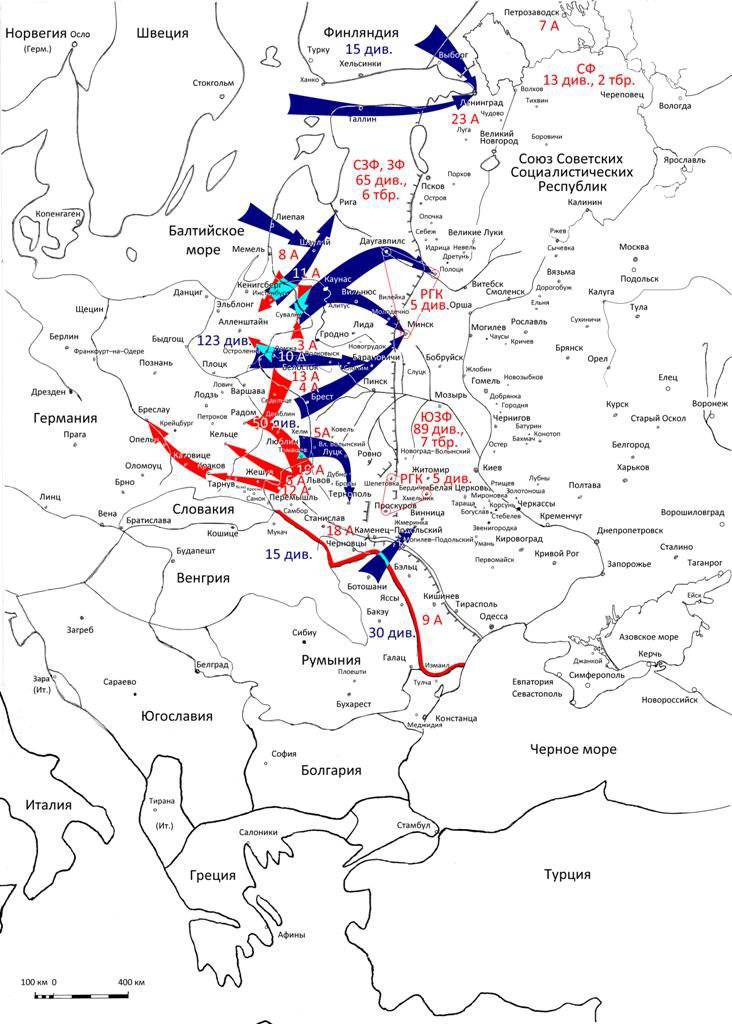
4 schema. Actions of the Armed Forces of the Red Army in the European theater of operations according to the 18 September plan for 1940 deployment. Compiled according to a note by the NO of the USSR and the National Space Directorate of the Central Committee of the CPSU (B) - I.V. Stalin and V.Molotov on the basics of deploying the armed forces of the Soviet Union on West and East on the 1940 and 1941 years // 1941. Collection of documents. In 2 pr. Prince 1 / Document No. 117 // www.militera.lib.ru
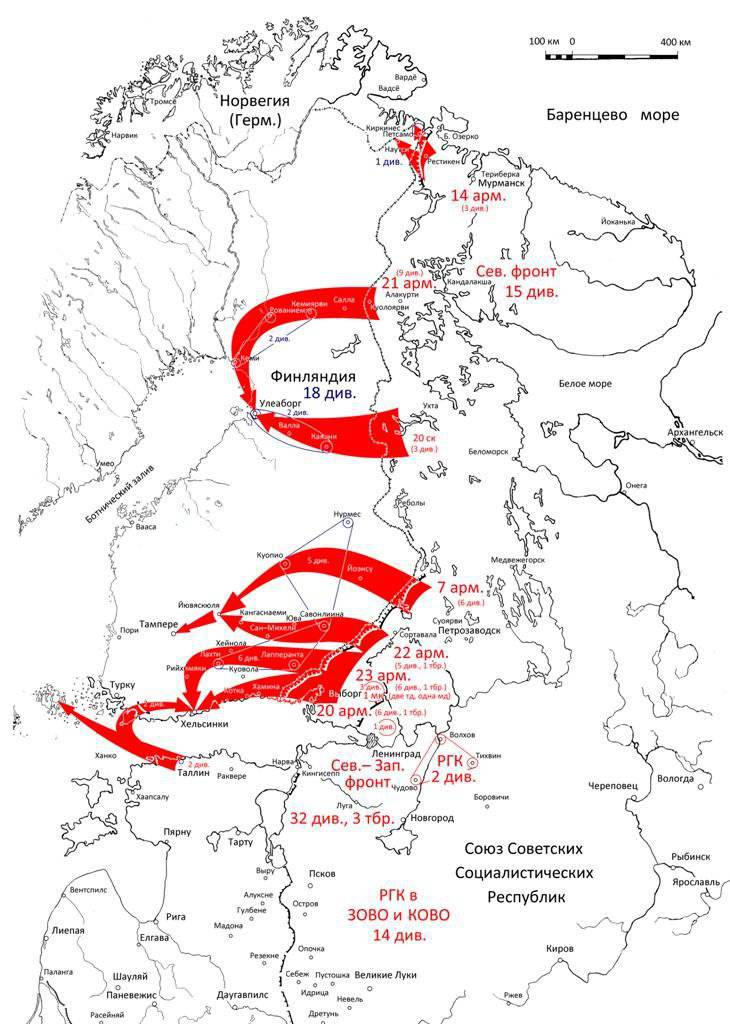
5 schema. Actions of the Armed Forces of the Red Army against Finland in accordance with the 18 September plan for 1940 deployment. Compiled according to a note by the NO of the USSR and the Space Forces NGSH in the Central Committee of the CPSU (b) - I.V. Stalin and V.Molotov on the basics of deploying the armed forces of the Soviet Union War with Finland // 1941. Collection of documents. In 2 pr. Prince 1 / Document No. 118 // www.militera.lib.ru
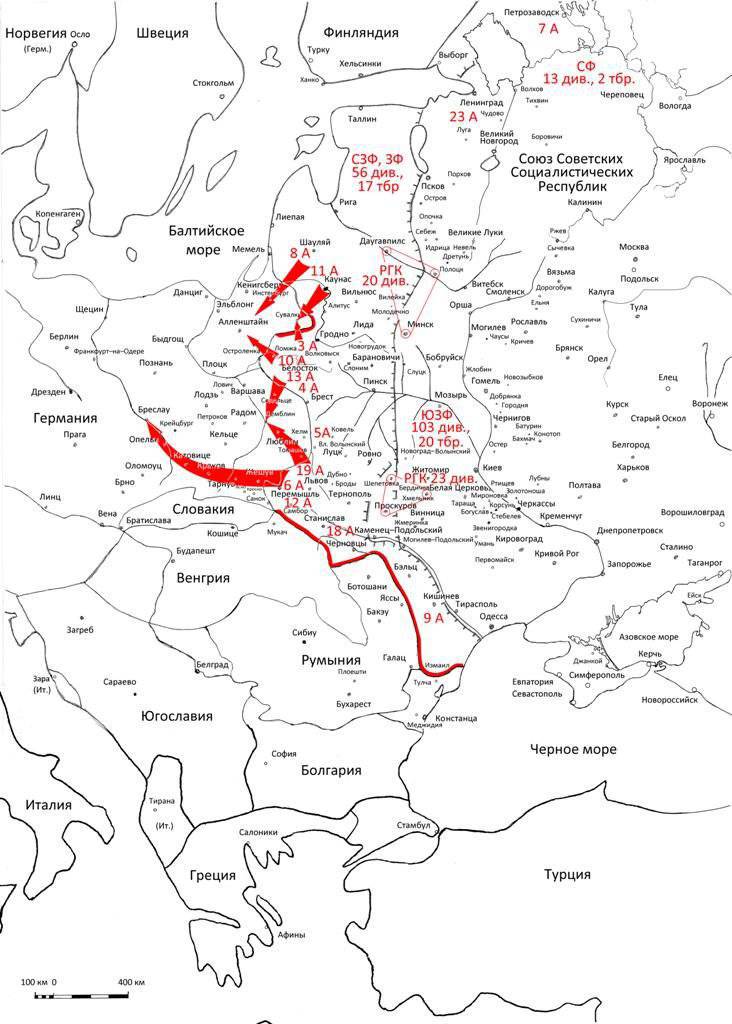
6 schema. Actions of the Armed Forces of the Red Army in the European theater of operations according to the 5 plan of October 1940 from the deployment. Compiled according to a note by the NO of the USSR and NGS KA in the Central Committee of the CPSU (b) - I.V. Stalin and V.Molotov on the bases of deployment of the armed forces of the Soviet West and East for 1941 years // 1941. Collection of documents. In 2 pr. Prince 1 // www.militera.lib.ru
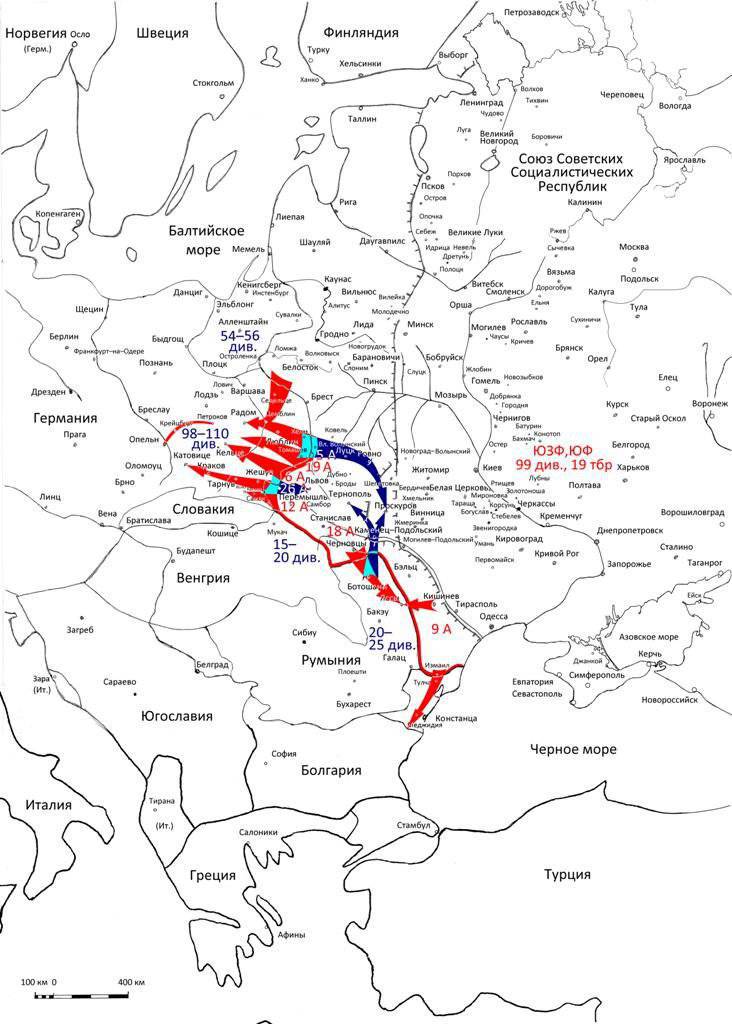
7 schema. The actions of the troops of the South-Western Front according to the deployment plan for 1940 year. Compiled from a note by NS KOVO. December 1940 of the Year // 1941. Collection of documents. In 2 pr. Prince 1 / Document No. 224 // www.militera.lib.ru
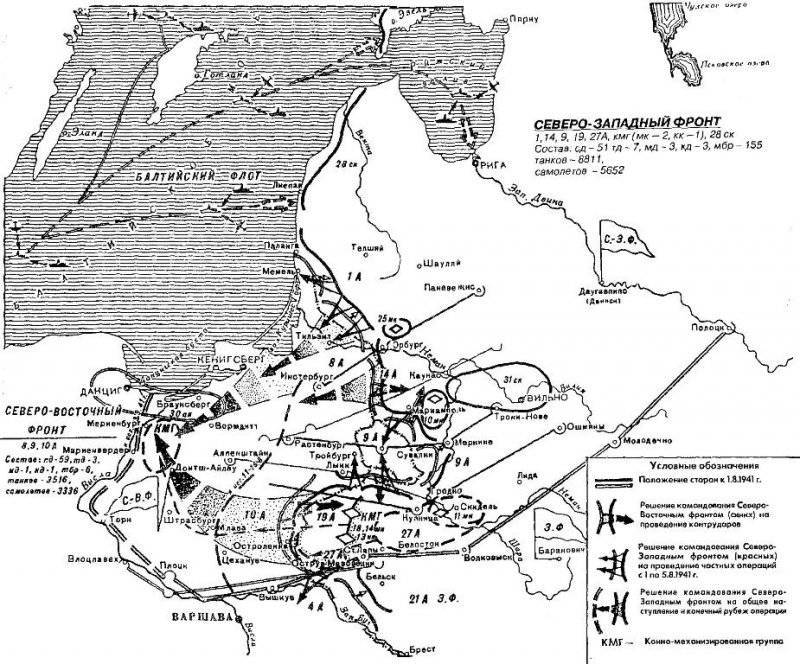
8 schema. The initial situation and the decisions of the parties on the first strategic game, held in the General Staff of the Red Army in January 1941. Copied by: Zakharov M.V. On the eve of great trials / General Staff in the pre-war years. - M., 2005. C. 366-367.
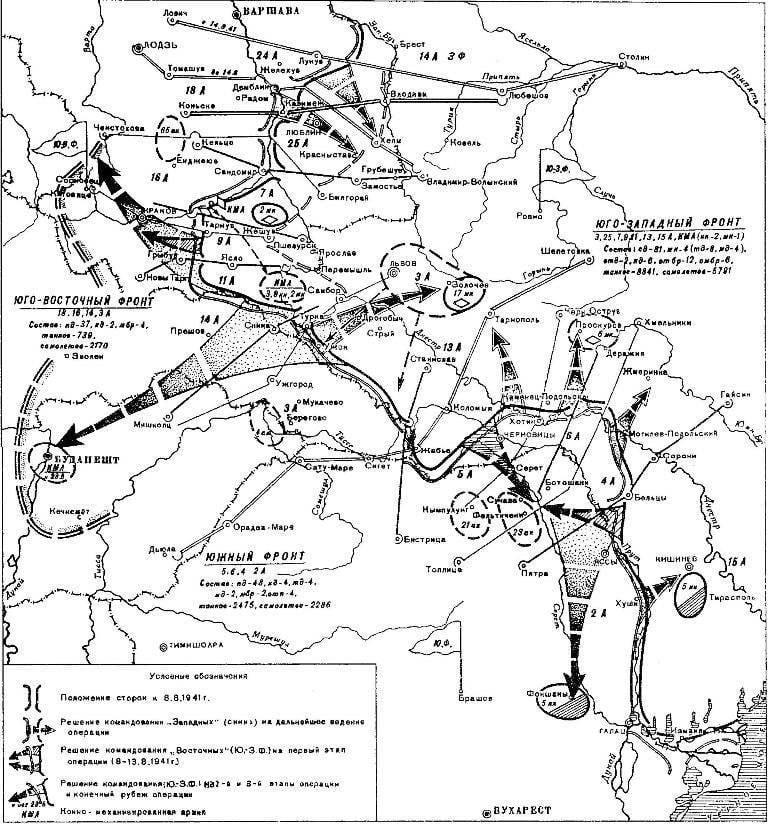
9 schema. The initial situation and the decisions of the parties on the second strategic game, held in the General Staff of the Red Army in January 1941. Copied by: Zakharov M.V. On the eve of great trials / General Staff in the pre-war years. - M., 2005. C. 370-371.
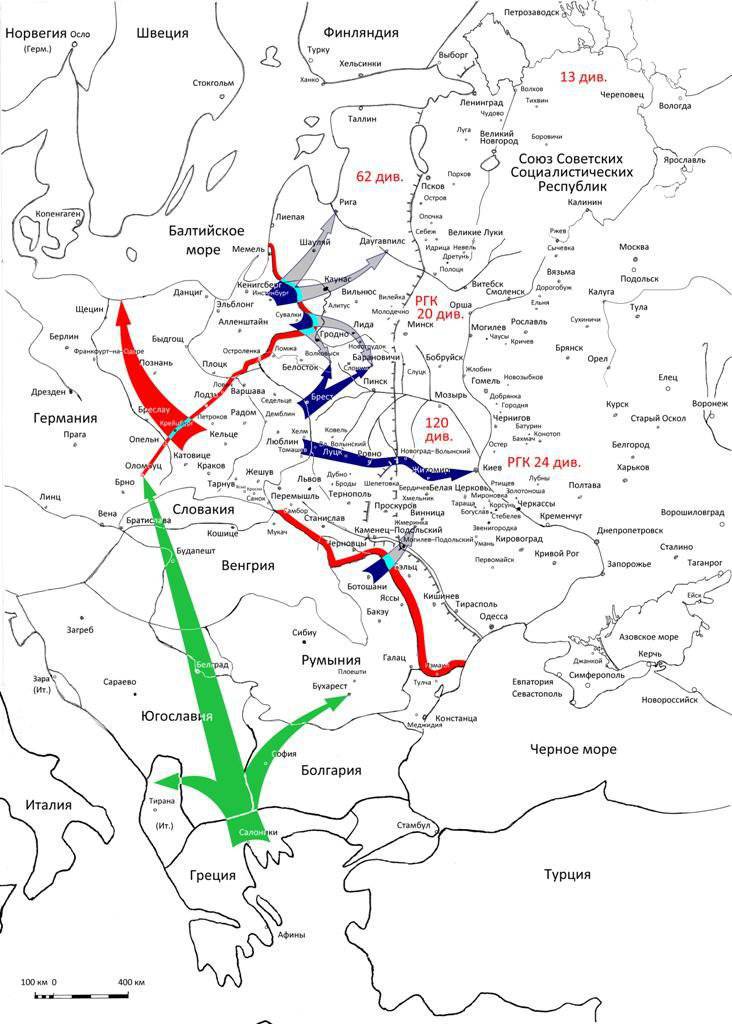
10 schema. Actions of the Armed Forces of the Red Army in the European theater of operations according to the strategic deployment plan of March 11 from 1941. Reconstruction of the author. Compiled according to the note of the USSR BUT and NGS KA // 1941. Collection of documents. In 2 pr. Prince 1 / Document No. 315 // www.militera.lib.ru
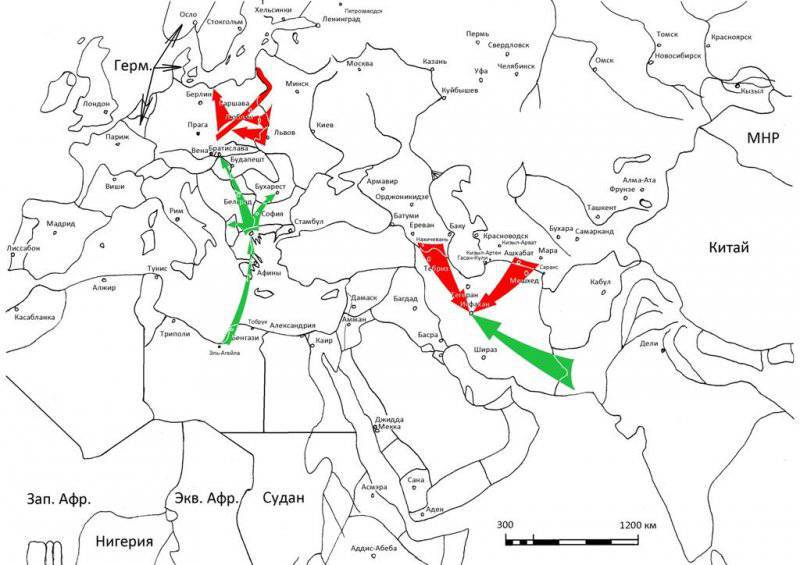
11 schema. Joint actions of the Armed Forces of the Red Army and Great Britain in accordance with the strategic deployment plan of March 11 in 1941. Reconstruction of the author. Compiled according to the note of the USSR BUT and NGS KA // 1941. Collection of documents. In 2 pr. Prince 1 / Document No. 315 // www.militera.lib.ru; Shtemenko S.M. General Staff during the war. In 2 pr. Prince 1 / 2-ed., Corr. and add. - M., 1975. - S. 20-21; Encyclopedia of the Second World War. Battle in the south: May 1940-June 1941 / Trans. from English - M., 2007. - S. 70 — 71.
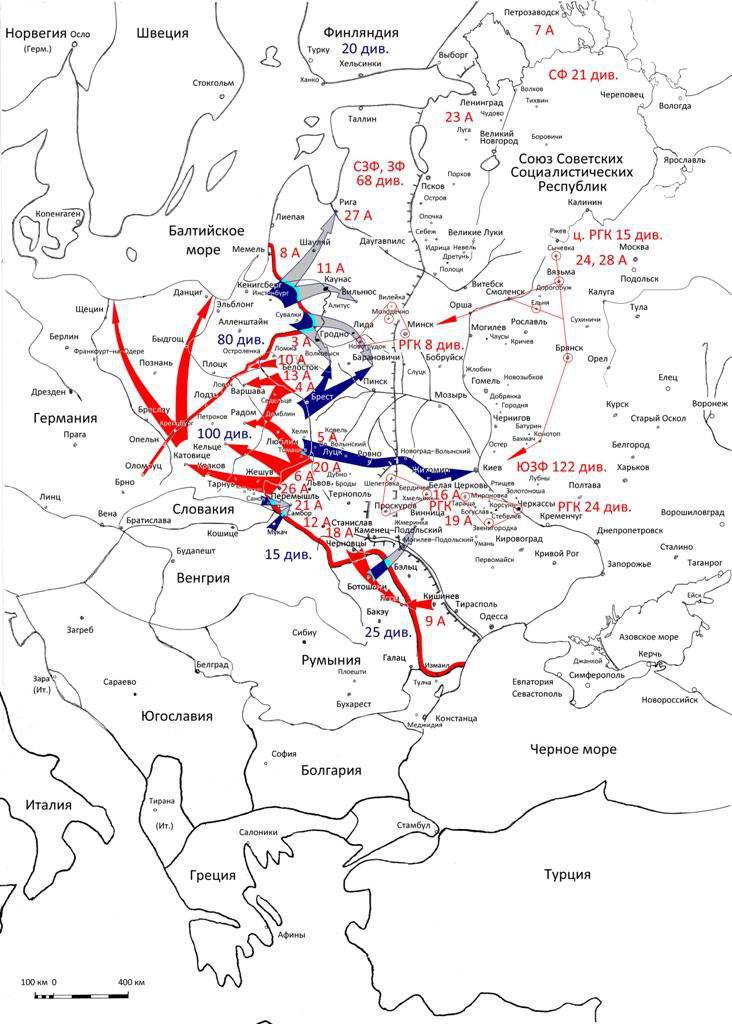
12 schema. Actions of the Armed Forces of the Red Army in the European theater of operations in accordance with the deployment plan of 15 in May of 1941 Stalin with considerations on the strategic deployment plan of the armed forces of the Soviet Union in case of war with Germany and its allies // 1941. Collection of documents. In 2 pr. Prince 2 / Document No. 473 // www.militera.lib.ru
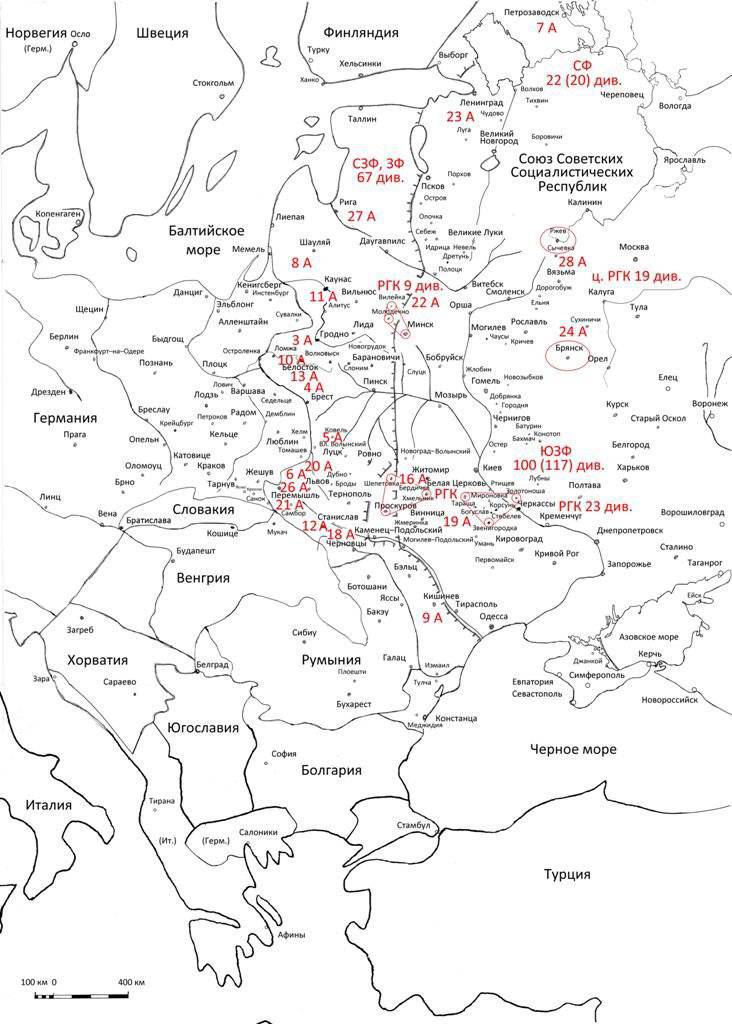
13 schema. Grouping of the Armed Forces of the Red Army in the European theater of operations according to the deployment plan of 13 in June 1941. Compiled according to the certificate of the deployment of the USSR Armed Forces in case of war in the West // 1941. Collection of documents. In 2 pr. Prince 2 / Document No. 550 // www.militera.lib.ru
Information